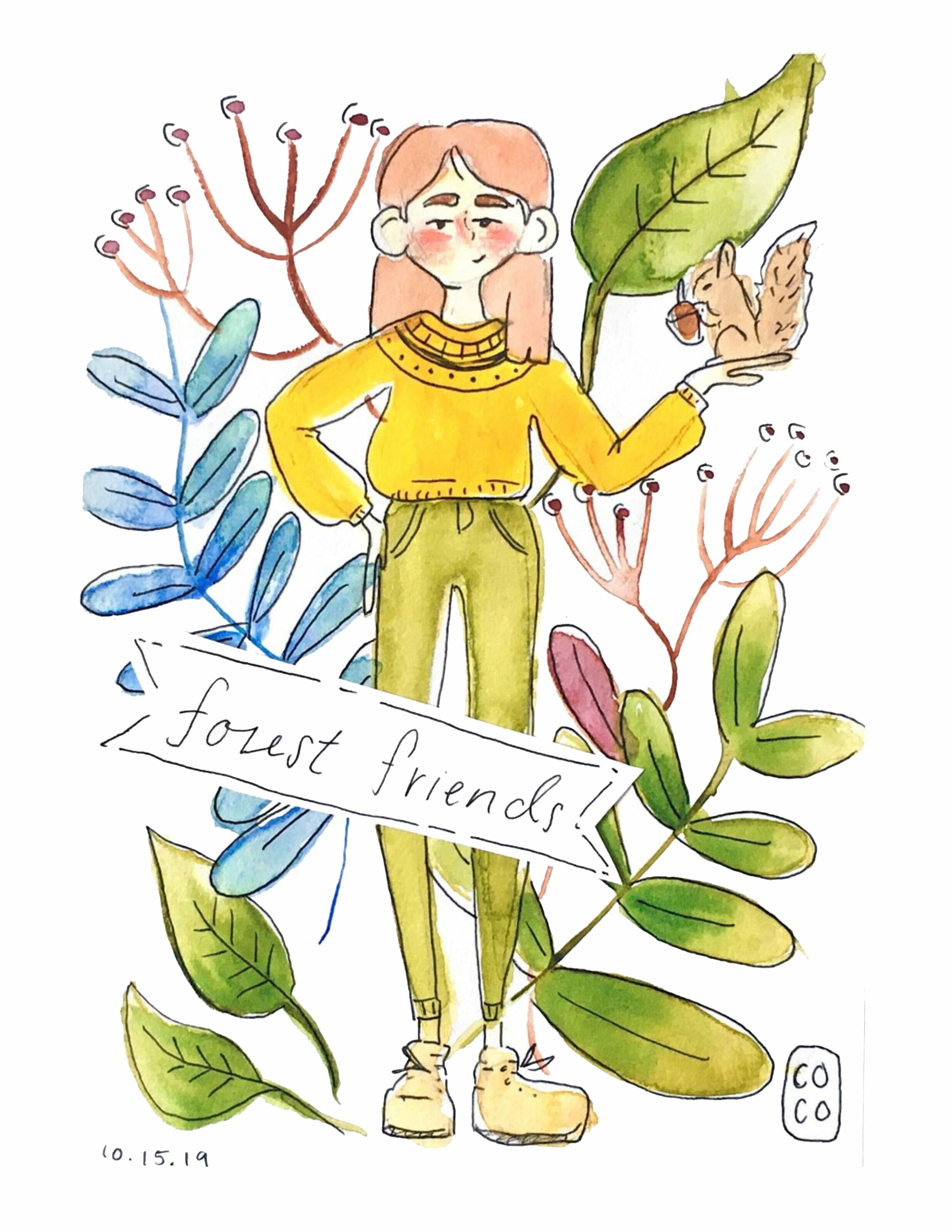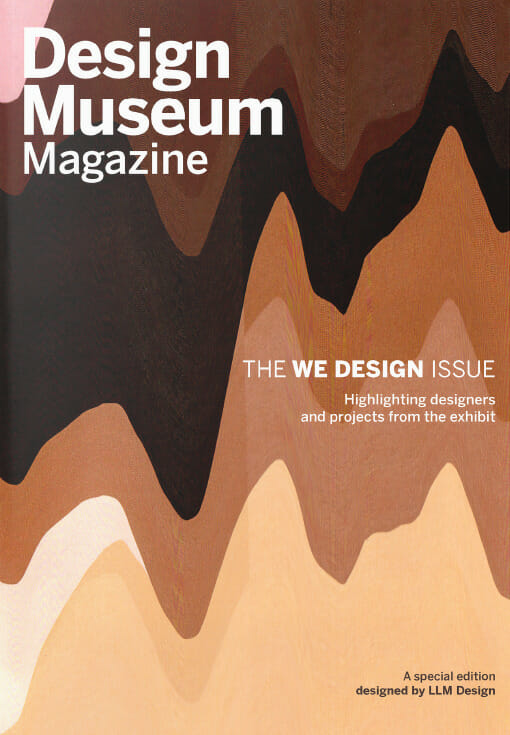Mindful Feedback

Artwork By Catherine Clarke
By Catherine Clarke, Graphic and Information Design Graduate
Content warning: Mental health, mental illness, sexual assault, sexual harassment
I’m a quiet and gentle person, and I have a lot of joy in my life. My art and design work is best described as happy: bright reds and yellows, bubbly shapes, and smiling characters. It may seem like positivity comes easily for me, but I have to work extremely hard to enjoy life. I’ve been struggling with post-traumatic stress for years, along with depression and anxiety, and surviving each day can feel like a full-time job. It’s difficult to escape a victim mindset, especially after enduring sexual assault as a girl.
Going to design school was a big risk because there is so much room for subjectivity and criticism. I have been lucky enough to participate in many design studio courses, and subsequently, countless critiques. Critique is one of the hardest parts of university for me. Putting my hard work on display and asking for feedback makes me feel extremely vulnerable and can trigger flashbacks and panic. I identify as a highly sensitive person. This realization has strengthened my focus on careful and empathetic design paired with mindful feedback.
Trauma manifests differently for everyone. For me, it was months of denial and shame, then extreme sadness and isolation. After surviving a pattern of sexual abuse, I had to un-learn many coping behaviors I had developed out of desperation. I had a habit of lying and withholding information from my friends and family. I thought that I was protecting myself, but I was only making things more complicated. I also fed into negative self-talk and started engaging in self-harm. Whenever I made a mistake, I was incredibly hard on myself. I had low selfesteem, so any small error made me feel even worse about myself. I would punish myself frequently, and I believed that it was what I deserved. The combination of denial and self-harm translated into perfectionism. I put so much effort into everything I did to try and avoid criticism and the subsequent self-harm. I am proud of my hardworking attitude and the progress I observed, but it set me up for disappointment. Even if I had given a project everything I had, emotionally, physically, intellectually, I would inevitably get criticism. But I saw receiving feedback as failing because I thought that if I worked hard enough, there would be no need for feedback.
A critique is a feedback session on a piece of artwork, in progress or completed. This process is crucial for any project because it helps expand existing ideas and provides the presenter with honest reactions and input. The feedback process can look different depending on the project’s stage and industry. In the early stages of a project, it’s often helpful to conduct empathy interviews: a preliminary, open-ended conversation with potential users. These interviews can reveal the user’s behaviors, wants, and needs and guide a designer to create a project that best suits potential clients. Once a prototype is developed based on these conversations, the designer might do user testing and ask people to try the product or service to observe their pain points. The designer would then make changes to the prototype and create a high-fidelity product based on user testing. In design school, this is typically the point where a formal critique would take place. Each student displays their hard work, and the class discusses every project, one by one. I have a lot of anxiety about this final step. I enjoy user research, interviews, and iterating because it’s usually informal and ever evolving. Still, the final critique feels physically and emotionally exhausting. Critique requires vulnerability, patience, focus, and courage, and there’s also the added pressure of getting graded or disappointing a client. People can also be harsh! Design is very subjective and personal, and sometimes a concept doesn’t make sense to everyone. I can remember a particularly tough critique when I was in my first year of university. I had spent weeks in the studio and the woodshop developing a fully fleshed-out toy with packaging and branding. I had semi-permanent goggle marks on my face and a wardrobe covered in paint and sawdust, and there were several studio sessions where I broke down in tears from the exhaustion and frustration of learning new tools. I was so invested in this project and felt proud of my outcome. During critiques, my professor wasn’t as enthusiastic. He seemed to like my project, but he bluntly pointed out minute execution flaws and areas where I ran out of time. He asked me what I would change if I had another week, and, defeated, I said I would redo the entire project. He said that wasn’t necessary and then made an insensitive joke about how I looked angry, which embarrassed me in front of my classmates. I said I wasn’t angry, and he dismissed it, saying that my expression was impossible to read. I felt mortified. I had worked so hard to create this project, and I didn’t know how to process the harsh feedback. My blank stare must have translated to anger, and my professor thought it was appropriate to provoke me.

Artwork By Catherine Clarke
I can understand my professor’s intentions during this critique. He wanted to help me improve my project, and he was sure to point out underdeveloped areas. It’s logical to expose flaws so that the designer knows what to fix. The good parts of the project don’t need to change, so why bother mentioning them?
I still struggle with this line of thinking. While my professor had good intentions, he also triggered me. A trigger is a detail, like a sight or a phrase, related to a traumatic event that may turn up in daily life and cause a fear response. I was triggered when my professor scrutinized my project and joked about my blank expression. While I knew I was technically safe, my body began to react to potential danger. First, I had received some harsh feedback and was struggling to separate feedback and failure. Second, this critique followed a similar pattern to my sexual abuse. I can remember being criticized and broken down by abusers and then being mocked for my angry or upset reaction. I felt a similar kind of stress during the critique as I did when experiencing a traumatic event.
Critique is a two-way process, and poor communication and tone can turn genuine and honest feedback into terrible, triggering feedback. During my time at partial hospitalization programs, I learned about the GIVE method; an interpersonal effectiveness concept taught in dialectal behavioral therapy (DBT). GIVE is an acronym for Gentle, Interested, Validate, and Easy-going, and it helps people create and maintain healthy relationships. In a critique setting, GIVE is an excellent guideline for providing feedback. This framework is gentle and friendly, which works to minimize the possibilities of triggering someone. It also emphasizes the validation of hard work and effort and positively reinforces good choices. There is still room for suggestions and improvements, but the tone of the conversation is never confrontational or offensive. Maintaining GIVE qualities in a conversation is not easy; it requires a lot of energy and dedication. However, it’s always better to try GIVE skills imperfectly than not to use them at all. Besides, practicing these skills will only make them easier! In the event of triggering a student or classmate, it’s best to apologize first and then use GIVE skills again. Validate their emotions and take accountability for your words. We can’t always know what might trigger someone. Some people can be triggered by certain smells, weather, songs, and more. Triggers can be unavoidable, but mindfully incorporating GIVE skills in the classroom can minimize the effects. If my professor did practice GIVE skills from the previous example, he may have adjusted his tone to be more soft and friendly, made eye contact, and given me time to explain my process. It is still possible to give critique and point out flaws while maintaining a positive and supportive demeanor. I would have welcomed any feedback he had for me because I would feel safe.
Using GIVE skills can also help prevent a culture of shame. When trying to create a mindful and inclusive critique, it’s important to be cautious with harsh words, sarcasm, and tough love. The problem with these communication styles is that it often makes the recipient feel ashamed. Shame is a complicated emotion that actually can result in a fear response, similar to fight-or-flight. Physiologically, shame is connected to the brain’s limbic system, which is responsible for automatic responses and survival. When the limbic system is activated, the body is flooded with the stress hormone cortisol. Energy is directed towards defending and protecting yourself, just like in a physical attack. This also means that energy is not being utilized in the brain’s learning centers, such as the prefrontal cortex, the area of the brain responsible for logical thinking. The only goal of a critique should be to learn and improve, but it is nearly physically impossible to learn when experiencing shame. Being gentle and validating through the GIVE method is a good start to avoid shaming others, but we also have to be mindful of other things that might cause shame. As a highly sensitive person, many things can make me feel ashamed, like forgetting a small task, running late, even asking for help. Just like it is difficult to avoid certain triggers, creating a space without shame can be challenging because everyone experiences it a little differently. Shame may be inevitable, but a mindful critique environment can help minimize shame when learning is a priority.

Artwork By Catherine Clarke
The recipient of a critique can also engage in mindful behavior to alleviate automatic stress responses and manage potential triggers. It’s important to accept that you cannot control the tone of a critique, and sometimes people will not use GIVE skills. While this scenario is not ideal, difficult critiques still happen, and it’s important to plan accordingly. I like to cope ahead. This technique helps calm future stressors by priming your body and mind for a challenging interaction. For example, suppose I’m anticipating a difficult critique. In that case, I need to use all the coping skills I can ahead of time to prepare myself for potential triggers. This can start a few nights before a critique with a coping skill called Reducing Vulnerabilities.
Vulnerabilities are simple things like sleep, nutrition, hydration, and movement that create a strong foundation for productivity and learning. When I only get six hours of sleep, for example, I am chipping away at that strong foundation and am more likely to fall into a crisis situation. Prioritizing basic self-care ensures a healthy state of mind. In addition, it promotes active listening, learning, and action steps when facing a critique. When I had that challenging critique, I stayed up too late in the studio, neglected my laundry, forgot to drink enough water, and deprived myself of relaxation time. I will not excuse my professor’s triggering remarks, but if I had reduced my vulnerabilities by getting more sleep and focusing on selfcare, I might have been able to accept the harsh feedback a little easier and could have interpreted the comments differently. I still might have been triggered, but at least I would have been in good health and in better shape to recover.
Another way to “cope ahead” is to actively practice a growth mindset. As defined by Stanford psychologist Carol Dweck, an influential researcher in this area, people with a growth mindset can develop their talents through hard work, good strategies, and input from others. The opposite of a growth mindset is a fixed mindset, which describes someone who believes their skills are innate and cannot improve in a meaningful way. People with fixed mindsets avoid failure and feedback. Instead, their success depends only on the confirmation and validation of their existing skills. I believe most people have a combination of both mindsets, as these examples are the two extremes of the spectrum. However, it is important to lean towards a growth mindset in any critique setting. Having a fixed mindset during a critique is incredibly painful since any negative comments or suggestions can evoke a sense of failure and shame.
Practicing a growth mindset can be difficult, especially for people dealing with trauma. Enduring traumatic events heightened my protective tendencies, manifesting in hyper-vigilance and paranoia. Survival and self-preservation became my priority, so I had a hard time understanding that being vulnerable and exposing my weaknesses would make me a better student. I found that practicing a growth mindset in small ways during my day helped me build up a healthy mindset for critique. I like to challenge myself when I begin to feel those protective boundaries creeping up in safe situations. For example, I’ll cook a new dish and allow myself to feel vulnerable by asking my family how it tastes. I’ll actively listen to their comments and keep reminding myself this will make me better. They love me, I am safe, and it is a privilege to hear their feedback. Sometimes I need to repeat this mantra every few seconds. A growth mindset does not come easily for me, so it helps to remind myself why I’m choosing to be vulnerable.

Artwork By Catherine Clarke
There are also ways I like to cope during a critique. In Dialectical Behavioral Therapy (DBT), self-soothing through your five senses can help in a tense situation. This technique allows me to take a break from my surroundings, connect with my body, and focus on something comforting. I enjoy using taste, as appropriate. A small snack is comforting to have, such as a piece of fruit or some dark chocolate. If eating is not permitted, drinking tea, coffee, kombucha, or water is another great option. I also like using touch by wearing soft, comfortable clothing or bringing a small item, like a smooth rock or stress ball, to hold.
I also try to turn off my emotional mind and act as an observer during a critique. I take a lot of notes to process the feedback later, in a comfortable and private place.
During critique, I am simply writing a transcript for my future self, which takes the pressure off my present, more vulnerable self. Once the critique is over, I still have a lot of work to do. I have to process and analyze pages of notes and diagrams and decide which changes I want to implement, which can be difficult, but it’s much better than facing a crisis during critique. This technique helps me use my wise mind. In DBT, the wise mind is the intersection of the reasonable mind and the emotional mind. It helps us operate with balance and intuition. During the critique, I try to only use my reasonable mind by processing logical observations and facts. This helps me detach from the situation and allows me to feel safe and protected during a vulnerable experience. After the critique, I allow my emotional mind to analyze the information in a safe and comfortable space to decide which comments I agree with and the changes that I can make while staying authentic to my vision. I can also give myself space to feel proud, angry, frustrated, or inspired. Finally, my wise mind takes over and helps me balance the emotional connection to my project and the logical feedback from the critique. As a result, I am also able to create reasonable action steps and improve my project.
It’s vulnerable to offer your hard work to feedback. If you love what you do, it makes sense to take feedback personally. Dealing with mental health issues only makes criticism harder to process, but there are ways to make the design space more safe and inclusive.
We need to gently guide students and employees through the critique experience using mindfulness and evidence-based communication techniques. We need to validate good ideas. We need to be sensitive to possible triggers. And we need to remind ourselves that mindful feedback is not easy and that it takes a lot of practice to communicate effectively. My identity as someone with post-traumatic stress has helped me prioritize healthy communication and mindful design. I believe we can make design feedback safe for everyone.
Triggers for PTSD
https://www.mayoclinic.org/diseases-conditions/ post-traumatic-stress-disorder/symptoms-causes/ syc-20355967
Dr. Shapiro TEDx Talk
https://www.youtube.com/watch?v=IeblJdB2-Vo DBT
Wise Mind
https://www.mindfulnessmuse.com/dialecticalbehavior- therapy/what-is-wise-mind
